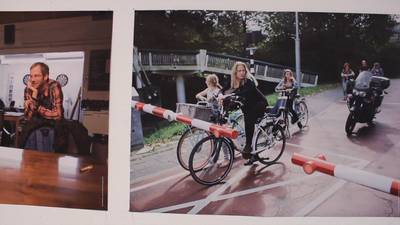The fifth book in the Ebifananyi series is based on the memoirs and slide collection of Engineer Martin Wangutusi Wambwa (b. 1928). He is one of the first western trained Ugandan engineers. Journalism and photography would have been his second vocational choice, had his engineering ambitions not worked out.Uhuru (Swahili for freedom/independence) works towards and around the idea of Uganda’s independence. Wambwa’s slides show a (literally and figuratively speaking) colourful, clean and optimistic place. His memoirs take us through what it meant and took for him to be educated the way he was, leading to a climax in which things started to change from ‘Uhuru na kazi’ (Freedom and Work) to ‘Uhuru na vita’ (Freedom and War).Three contemporary photographers were invited to engage with and respond to Wambwa’s photographs. Elsadig Mohamed (SD), Luuk van den Berg (NL) and Rumanzi Canon (UG) did this with each a different visual strategy related to their own practices as photographers.The work presented in this book was part of the City Remixing exhibitions that took place in Uganda (March 2016) and The Netherlands (April 2016). Video documentation of the shows is also available: NL, and UG.
DOCUMENT
Parallele portretten.Wat is een portret? En welke positie hebben ouderen in onze samenleving? Deze vragen vormden het vertrekpunt voor een interculturele dialoog tussen studenten en docenten van Academie Minerva en Uganda Christian University. Het idee van het portret is via verschillende media onderzocht, met directe waarneming als gemeenschappelijke factor. Gedurende het traject werden de persoonlijke ervaringen en het artistieke proces van de deelnemers gedeeld in een Facebook-groep. Dit resulteerde in portretten van ouderen in Nederland en in het Oost-Afrikaanse Oeganda. Opvallend is dat al het werk gemaakt in Oeganda tot stand kwam vanuit familierelaties, terwijl de Nederlandse studenten voornamelijk via nieuwe contacten met ouderen werkten. Illustreert dit de kracht van Oegandese familiebanden? En het gemakkelijk aangaan van nieuwe relaties en samenwerkingsverbanden in Nederland? Deze tentoonstelling toont zowel de portretten, als de interactie die plaatsvond tijdens het project. Zichtbaar is zowel de ontmoeting tussen culturen als tussen generaties.Te zien is werk dat zowel door studenten als door begeleidende docenten gemaakt werd zonder dat daarin een hiërarchie aanwezig gesteld wordt. Passend bij de manier waarop de onderzoeksgroep PRICCAPractice, waar dit project uit voort komt, functioneert, namelijk als onderzoeksgemeenschap waarin iedere deelnemer vanuit zijn eigen expertise werkt en vragen omtrent het gebruik van fotografisch beeld in artistieke praktijken beantwoordt.Vanuit Nederland: Lola Diaz Cantoni, Anna Emmink, Anouk Enders, Herman van Hoogdalem, Wytze Hoogslag, Eline Leenders, Laura LaasikVanuit Oeganda: Piloya Irene, Martha Namutosi, Eria Nsubuga, Nathan Omiel, Andrea Stultiens & Kaddu Wasswa (zaaltekst)
MULTIFILE

With this project we strived to contribute to structural reduction of post-harvest food losses and food quality improvement in the Kenyan avocado and dairy value chains through the application of technical solutions and tools as well as improved coordination in those food chains. The consortium had four types of partners: 1. Universities (2 Kenyan, 4 Dutch), 2. Private sector actorsin those chains, 3. Organisations supporting those chains, and 4. Network partners. The applied research has been implemented in cooperation with all partners, whereby students at involved universities conducted most of the field studies and all other consortium partners support and interact depending on the phases.The FORQLAB project targeted two areas in Kenya for both commodities, a relatively well-developed chain in the central highlands and a less-develop chain in Western-Kenya. The research methods were the business to business and multi-stakeholder (living lab) approaches to increase the potential for uptake of successful interventions in the chain. The project consisted of four phases: 1. Inventory and inception, 2. Applied research, 3. Spreading research outputs through living lab networks, 4. Translation of project output in curricula and trainings. The outcomes were: two knowledge exchange platforms (Living Labs) supported with some advice for sustainable food loss reduction, a research agenda, proposals for ICT and other tech solutions and an implementation strategy; communication and teaching materials for universities and TVETs; and knowledge transfer and uptake.
DOCUMENT
